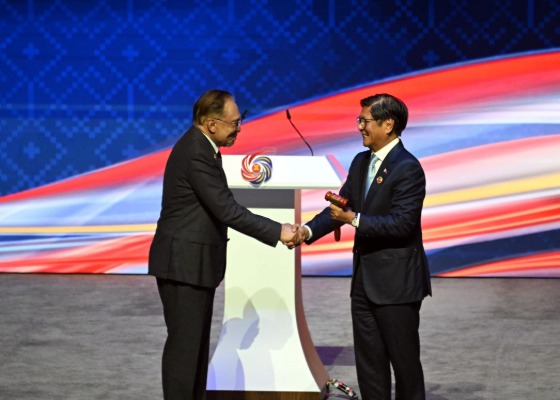47th ASEAN Summit: Steadiness amid shifting tides
Joanne Lin, Melinda Martinus and Kristina Fong examine the outcomes of the 47th ASEAN Summit and assess Malaysia’s achievement as the ASEAN Chair.
30 October 2025

The 47th ASEAN Summit and Related Summits in Kuala Lumpur took place amid global economic uncertainty and shifting geopolitical alignments. Against the backdrop of tariff wars, regional conflicts, and intensifying US–China rivalry, Malaysia’s chairmanship delivered a steady and well-coordinated series of meetings that reinforced ASEAN’s unity and convening power.
Despite the absence of key leaders such as China’s Xi Jinping, India’s Narendra Modi, and Russia’s Vladimir Putin, the gatherings saw full participation from ASEAN’s dialogue partners, including the high-profile return of US President Donald Trump. More than 20 related meetings were convened, including the 20th East Asia Summit, the 5th Regional Comprehensive Economic Partnership (RCEP) Summit, and ASEAN’s engagements with major partners such as China, Japan, South Korea, and Australia.
Here are seven key takeaways from the Summit.
Timor-Leste’s full admission: a milestone of inclusivity
The admission of Timor-Leste as ASEAN’s 11th member completes the geographic footprint of Southeast Asia and reinforces the bloc’s long-standing narrative of inclusivity, a principle central to Malaysia’s 2025 chairmanship theme. Beyond its symbolic value, the move carries strategic and institutional implications. It reflects ASEAN’s willingness to prioritise regional solidarity, signalling confidence in its capacity to support Dili’s integration into ASEAN’s complex bureaucracy.
Timor-Leste’s accession also strengthens ASEAN’s legitimacy as a truly Southeast Asian organisation and reaffirms its identity as a community that grows by consensus rather than exclusion. Yet it also tests ASEAN’s institutional processes. The regional organisation must now deliver on promises of capacity-building and ensure that the new member can participate meaningfully in decision-making processes. How ASEAN manages this integration will serve as a litmus test of its cohesion, adaptability, and commitment to narrowing development gaps within the region.
The return of President Trump
President Trump’s return to Southeast Asia—after skipping the ASEAN Summits in 2018, 2019, and 2020 during his first administration—underscores US re-engagement with the region. His visit was tied closely to his role in brokering the Thailand–Cambodia ceasefire, later enshrined as the Kuala Lumpur Accord. This was rich in optics.
Trump’s self-styled “peacemaker” image and talk of a Nobel Peace Prize moment aside, his presence sent a pragmatic signal: that the US remains invested in ASEAN’s multilateral processes, as he assured leaders of “100 per cent commitment” to Southeast Asia and would remain a strong partner. While Washington’s engagement remains transactional and bilateral in form, the symbolic value of having a sitting US president at the table cannot be understated. It helped restore ASEAN’s profile as a convenor of consequential diplomacy—even if much of the attention centred more on personalities than policies.
New alliances in a shifting geo-economic landscape
Malaysia’s 2025 chairmanship was characterised by a balance between visibility and pragmatism. Prime Minister Anwar Ibrahim sought to elevate ASEAN’s global profile while maintaining a focus on practical outcomes.
Kuala Lumpur expanded ASEAN’s external engagement beyond its traditional partners, inviting Brazil’s President Luiz Inácio Lula da Silva and South Africa’s President Cyril Ramaphosa to highlight the bloc’s growing alignment with Global South priorities. This followed the successful convening of the inaugural ASEAN–Gulf Cooperation Council (GCC)–China Summit in May. While this approach increased ASEAN’s visibility, Malaysia paired its diversification ambitions with a grounded strategy, advancing geoeconomic coordination through the ASEAN Geoeconomics Task Force to respond to tariff threats, increase resilience, and anchor the implementation of the ASEAN Community Vision 2045. The establishment of the ASEAN Centre of Excellence (CoE) for Micro, Small, and Medium Enterprises (MSMEs) in the Green Transition represents a concrete effort to reconcile inclusivity with a stronger regional industrial strategy, strengthening the role of MSMEs in driving sustainable growth.
Fine-tuning grand plans for stronger economic integration
The Joint Leaders’ Statement on the RCEP reiterated the importance of effectively implementing the trade agreement in a timely manner and amid an increasingly volatile geopolitical landscape. The RCEP, which stands as the largest FTA in the world, constituting around 30 per cent of global GDP and population, has had a slow start. Utilisation rates have been low. This can be attributed to the RCEP’s preferential terms not being as competitive as some other ASEAN-plus Agreements such as the ASEAN-China FTA and the ASEAN-Australia-New Zealand FTA. The proposed establishment of the RCEP Secretariat and the commencement of the General Review of the Agreement in 2027 can set the foundation to upgrade the RCEP to be more attractive. This would boost its utilisation and enhance economic resilience.
Also well aligned with the region’s objectives to pursue more meaningful economic integration and remain relevant in the face of changing economic dynamics, the upgraded ASEAN Trade in Goods Agreement (ATIGA) as well as the ASEAN-China Free Trade Area (ACFTA) 3.0 Upgrade were also signed at the sidelines of the 26th ASEAN Economic Community Council Meeting. These FTAs are two of the most utilised, and are well-established in the region. Thus, the upgrades will serve to strengthen supply chain resilience through the more effective alleviation of trade frictions such as those coming about from complicated customs procedures. The two FTAs also include newer areas important in trade discussions such as environmental factors and the digital economy.
Regional fault lines: Myanmar and the South China Sea
The Myanmar issue continues to show limited progress despite ASEAN’s sustained commitment to uphold the Five-Point Consensus. Leaders adopted the Review and Decision on the Implementation of the Five-Point Consensus, reaffirming that a cessation of violence and inclusive dialogue must precede elections. The grouping also agreed to explore the appointment of a longer-term ASEAN Special Envoy to ensure continuity in engagement and humanitarian access. At the same time, leaders refrained from endorsing Myanmar’s planned elections or deploying an observer mission, maintaining ASEAN’s principled stance against legitimising a process widely viewed as non-credible. Yet despite ASEAN’s sustained diplomatic engagement, it remains unlikely to influence or dictate the trajectory of Myanmar’s internal political developments.
On the South China Sea, no major breakthroughs were reported. As ASEAN–China dialogue coordinator, Malaysia reiterated the urgency of accelerating negotiations on a Code of Conduct in the South China Sea (COC)—a process which has taken more than a decade in the making, since formal talks commenced in 2018. Substantial progress, however, will likely depend on how the Philippines guides the process under its 2026 chairmanship, given the outstanding issues on geographical scope, legal status and enforcement mechanisms.
East Asia Summit: a platform struggling to shape outcomes
This year, the East Asia Summit (EAS) marked its 20th anniversary. The EAS once again highlighted ASEAN’s convening power but also its diminishing influence over major-power dynamics. Malaysia managed to bring together all 18 members, which was no small feat amid fractious geopolitics. But the Summit continues to fall short of shaping outcomes in a meaningful way. Joint statements are routinely watered down or stalled by rivalries among the major powers.
This year provided no exceptions. This prompted a reporter to ask Prime Minister Anwar during the closing press conference why the EAS could not issue a joint statement. The prime minister replied that many countries—including Russia, Myanmar, US and China—were present and willing to discuss issues, but he did not offer anything more substantive apart from saying that while there are disagreements, ASEAN “should not stop engaging”. This underscored the forum’s ongoing struggle to find consensus among its members. Furthermore, despite several leaders being in Kuala Lumpur, the US, Japan, South Korea, India, and Russia were represented at lower levels, underscoring the challenge of sustaining engagement within the EAS, which is increasingly viewed as a peripheral meeting rather than a Leaders-led platform.
From Kuala Lumpur to Manila: sustaining the momentum
As the dust settles on the Kuala Lumpur meetings, the 47th ASEAN Summit stands out for its steady, measured progress. Malaysia’s chairmanship combined diplomacy with delivery of tangible outcomes, from Timor-Leste’s accession and the Thailand–Cambodia peace accord to renewed economic frameworks that future-proof ASEAN against global disruptions.
Yet the work ahead is formidable. The Myanmar crisis and South China Sea disputes remain unresolved, and ASEAN’s strategic platforms like the East Asia Summit still struggle to shape outcomes in an increasingly polarised Indo-Pacific. As the Philippines takes over as the next Chair under the theme “Navigating Our Future, Together,” it must sustain the momentum Malaysia has built by translating ASEAN’s frameworks into action.
Joanne Lin is a Senior Fellow and Coordinator of the ASEAN Studies Centre at ISEAS – Yusof Ishak Institute.
Melinda Martinus is the Lead Researcher in Socio-cultural Affairs at the ASEAN Studies Centre, ISEAS – Yusof Ishak Institute.
Kristina Fong Siew Leng is Lead Researcher for Economic Affairs at the ASEAN Studies Centre, ISEAS - Yusof Ishak Institute.
Copyright: Fulcrum.sg
Image: ASEAN Secretariat / Kusuma Pandu Wijaya
How can we help? Get in touch to discuss how we can help you engage with Asia
